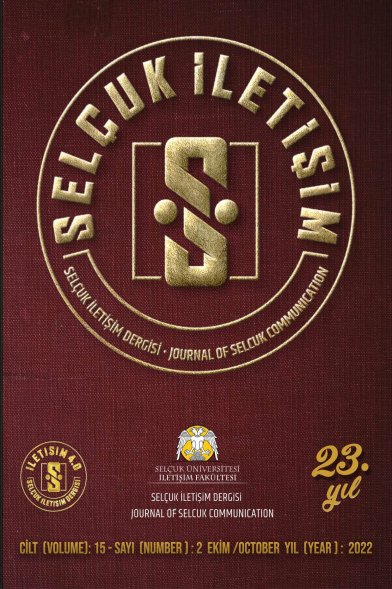Yalnızlık ve televizyon kullanımı
Yalnızlık hem bireysel hem de toplumsal bir fenomendir. Medya kullanımı ve televizyon izleme de yalnızlıkla baş etme stratejilerinden biridir. Bu yüzden yalnızlık ve televizyon kullanımı arasındaki bağlantıların ortaya çıkarılması önemlidir. Bu çalışmada, insanların yalnızlık seviyesine bağlı olarak hangi doyumları elde etmek amacıyla televizyon izlediği sorusuna cevap aranmıştır. Analiz sonuçları, yalnızlık düzeyi arttıkça televizyon izleme süresinin arttığını, yalnızların en çok televizyonda magazin programları, diziler ve sinema filmlerini izlediğini ortaya koymuştur. Yalnızlar arkadaşlık ve kaçış, zaman geçirme ve alışkanlık, eğlence ve sosyal etkileşim gereksinimlerini doyurmak için televizyon izlemektedirler. Ancak yalnızlık düzeyi arttıkça, televizyonda bilgilenme motivasyonuna verilen önem azalmaktadır.
Loneliness and television usage
Loneliness is both an individual and a social phenomenon. Media usage and watching television are some of the strategies to cope with loneliness. Therefore it is needed to reveal the correlations between loneliness and usage of television. In this research, the answer of the question on which satisfactions lead people to watch television according to their loneliness level is searched for. The analysis results had produced that, the more loneliness level increases, the more duration of watching television increases, and the lonely people mostly watch the magazine, soap operas and motion picture. Lonely people watch television to satisfy their needs such as companionship and escape, pass time, habits, entertainment, social interaction. Nevertheless as much as the loneliness level increases, the importance given to motive of being informed by television, decreases.
___
- Cacioppo J T, Hawkley L C, Ernst J M, Burleson M, Berntson G G, Nouriani B ve Spiegel D (2006) Loneliness Within a Nomological Net: An Evolutionary Perspective, Journal of Research in Personality, 40, 1054-1085.
- Canary D J ve Spitzberg B H (1993) Loneliness and Media Gratifications, Communication Research, 20 (6) December, 800-821.
- Çakır V (2005) Bir Sosyal Etkinlik Olarak Eğlence ve Televizyon (Konya Örneği), S. Ü. Sosyal Bilimler Enstitüsü Derg, 13, 123-142.
- Finn S ve Gorr M B (1988) Social Isolation and Social Support as Correlates of Television Viewing Motivations, Communication Research, 15 (2), April, 135-158.
- Gerson A C ve Perlman D (1979) Loneliness and Expressive Communication, Journal of Abnormal Psychology, 88, 258-261.
- Gülnar B ve Balcı Ş (2010) Yeni Medya ve Kültürleşen Toplum, LiteraTürk Yayınları, İstanbul.
- Kim J ve Rubin A M (1997) The Variable Influence of Audience Activity on Media Effects, Communication Research, 24, 107-135.
- Koçak A (2001) Televizyon İzleyici Davranışları Televizyon İzleyicilerinin Tercihleri ve Doyumları Üzerine Teorik ve Uygulamalı Bir Çalışma, Doktora Tezi, S. Ü. Sos. Bil. Enst, Konya.
- Peplau L A ve Perlman D (1982) Perspectives on Loneliness, L A Peplau and D Perlman (eds) Loneliness: A Sourcebook of Current Theory, Research, and Therapy, New York, Wiley-Interscience, pp 1-18
- Peplau L A, Russell D ve Heim M (1979) The Experience of Loneliness. I H Frieze, D Bar- Tal and J S Carroll (eds) New Approaches to Social Problems: Applications of Attribution Theory, San Francisco, CA, Jossey-Bass, pp 53-78
- Perlman D ve Peplau L A (1981) Toward a Social Psychology of Loneliness, R Gilmour and S Duck (eds), Personal Relationship: 3. Personal Relationships in Disorder, London, Academic Press, pp 32-56.
- Perlman D ve Peplau L A (1982) Theoretical Approaches to Loneliness, L A Peplau and D Perlman (eds), Loneliness: A Sourcebook of Current Theory, Research, and Therapy, New York: Wiley-Interscience, pp 123-134.
- Perlman D ve Peplau L A (1984) Loneliness Research: A Survey of Empirical Findings, L A Peplau and S Goldston (eds), Preventing the Harmful Consequences of Severe and Loneliness, U.S. Government Printing Office, pp 13-46
- Perlman D ve Peplau L A (1998) Loneliness, H Friedman (eds) Encyclopedia of Mental Health (Vol. 2), San Diego, CA: Academic Press. pp 571-581.
- Perse E M ve Rubin A M (1990) Chronic Loneliness and Television Use, Journal of Broadcesting & Elecktronic Media, 34 (1), Winter, 38-53.
- RTÜK (2009) Televizyon İzleme Eğilimleri Araştırması-2, Kamuoyu, Yayın Araştırmaları ve Ölçme Dairesi Başkanlığı.
- Rubenstein C ve Shaver P R (1982) The Experience of Loneliness, L A Peplau and D Perlman (eds), Loneliness: A Sourcebook of Current Theory, Research, and Therapy, New York, Wiley-Interscience, pp 206-223.
- Rubenstein C, Shaver P ve Peplau L A (1979) Loneliness, Human Nature, February, 58-65.
- Rubin A M (1981) An Examination of Television Viewing Motivations, Communication Research, 8, 141-165.
- Rubin A M (1983) Television Uses and Gratifications: The Interactions of Viewing Patterns and Motivations, Journal of Broadcasting, Winter, 27 (1), 37-51.
- Rubin A M (1984) Ritualized and Instrumental Television Viewing, Journal of Communication, 34 (3), 67-77.
- Rubin A M, Perse E M ve Powell R A (1985) Loneliness, Parasocial Interaction, and Local Television News Viewing, Human Communication Research, 12 (2), 155-180
- Russell D (1996) UCLA Loneliness Scale (Versiyon 3): Reliability, Validity, and Factor Structure, Journal of Personalitiy Assessment, 66 (1), 20-40.
- Russell D, Peplau L A ve Cutrona C E (1980) The Revised UCLA Loneliness Scale: Concurrent and Discriminant Validity Evidence, Journal of Personality and Social Psychology, 39 (3), 472-480.
- Russell D, Peplau L A ve Ferguson M (1978) Developing a Measure of Loneliness, Journal of Personality Assessment, 42 (3), 290-294.
- Yayın Aralığı: Yılda 2 Sayı
- Başlangıç: 1999
- Yayıncı: Selçuk Üniversitesi İletişim Fakültesi
Sayıdaki Diğer Makaleler
Yalnızlık ve televizyon kullanımı
AKSİYON FİLMLERİNDE İYİ VE KÖTÜNÜN TEMSİLİ: DIE HARD ÜZERİNE BİR İNCELEME
BİLGİSAYAR, İNTERNET VE VİDEO OYUNLARI ARASINDA ÇOCUKLAR
Bilgisayar, internet ve video oyunları arasında çocuklar
Yavaş Güzeldir: “YavaşYemek”ten “Yavaş Medya”ya hızlı tüketime dair bir çözüm önerisi
Ebru GÖKALİLER, Ayda AYBAR, Göker GÜLAY
DÜNYAYA AMERİKA'NIN GÖZÜYLE BAKMAK: AMERİKAN BASININDA ULUSLARARASI HABERLER 2007-2009
Dünyaya Amerika’nın gözüyle bakmak: Amerikan basınında uluslararası haberler 2007-2009
